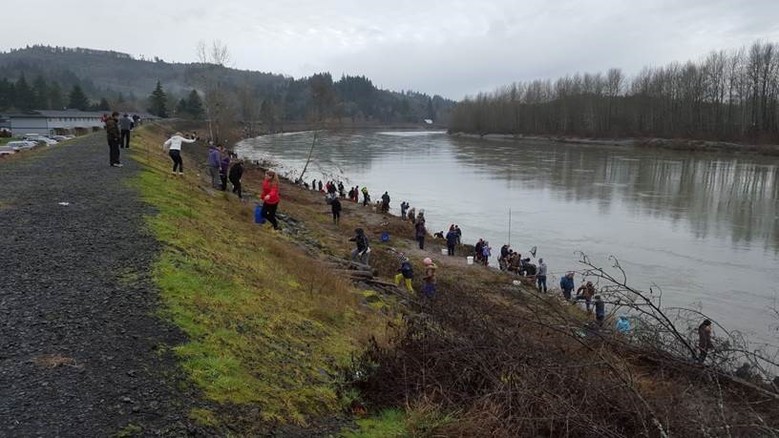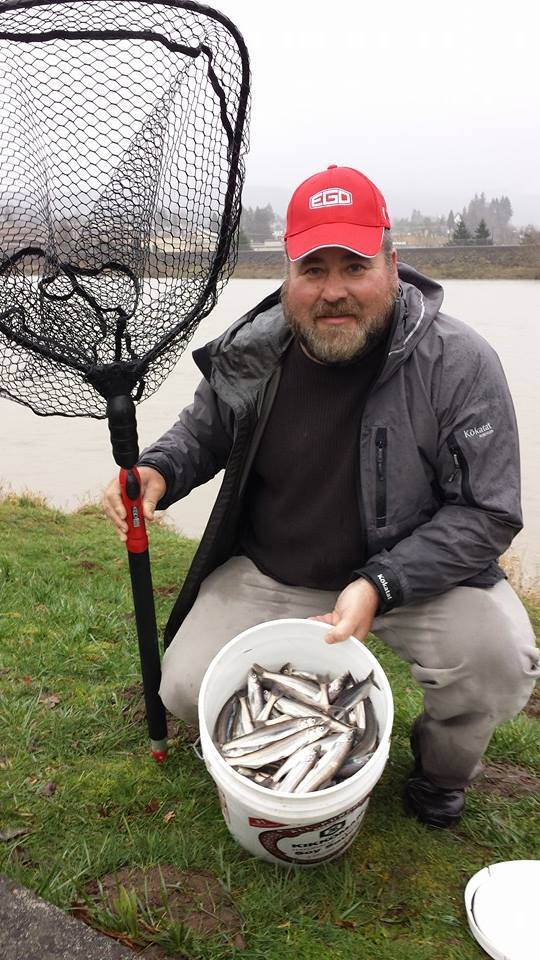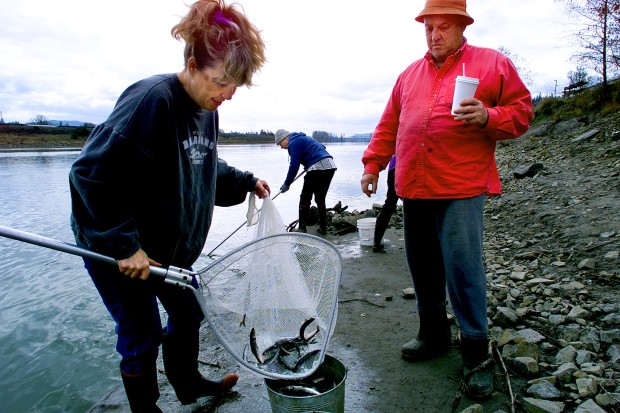Columbia River smelt have already arrived and fingers are crossed the run-size will be large enough to host a dip-net fishery in the Cowlitz River Leave a reply

By Mark Yuasa
If you follow the Pacific Northwest fishing scene like I do, then you know that this time of the year – while lean on actual on-water fishing – represents a lot of newsworthy information on many fronts.
Earlier today (Jan. 22), the Washington Department of Fish and Wildlife (WDFW) released their winter “fact sheet” on the Columbia River smelt stock status, and there are some signs of hope on the horizon peppered with a pandemic uncertainty for these highly sought-after migratory fish.
“From some of our initial abundance surveys in recent days, we know there are smelt in the river right now,” said Laura Heironimus, a WDFW biologist. “We know it’s going to be a moderate run size this year. We’ve gotten approval from NOAA Fisheries (National Oceanic and Atmospheric Administration) on a proposed harvest plan. Any sport season will depend on in-season indicators plus an additional layer of issues tied to COVID.”
Before the joint Washington and Oregon fisheries staff can move forward with the proposal there is a compact meeting this Tuesday (Jan. 26) to get feedback on recommendations so “nothing is set in stone just yet,” according to Heironimus.
Smelt (also referred to as a eulachon) return annually to the Columbia River to spawn in the mainstem and several of its tributaries downstream of Bonneville Dam. The fish typically begin to enter the river in December and peak tributary abundance is usually in February.
The Columbia smelt are listed as threatened under the federal Endangered Species Act (ESA). Smelt abundance increased steadily from 2011 to 2014, reaching an estimated recent peak abundance of 16.6 million pounds in 2014, followed by a huge decline to 370,000 pounds in 2018.
The 2019 return improved to an estimated 4.2 million pounds and was the highest since 2016 and 66 percent of the 2011 to 2018 average.
In response to the ESA listing in 2010, both states closed commercial and recreational smelt fisheries during 2011-2013. Since 2014, the states have worked closely with the National Marine Fisheries Service (NMFS) to conduct research-level smelt fisheries that provide biological data and pounds per landing data so that smelt status and run strength can be better assessed.

“Due to sampling constraints imposed by COVID-19, the 2020 run-size couldn’t be determined directly from larval sampling, but the estimate suggests the 2021 return should be right around the 2019 figure,” Heironimus said.
Abundance indicators for the 2021 smelt return suggest a stronger return of age-3 and age-4 smelt and a weaker return of all other age-classes. The 2021 return should fall somewhere between 3.8- and 4.2-million pounds, similar to the past two years.
Provided the recommendation is OK’d after Tuesday’s public input meeting, Washington and Oregon fishery managers along with the National Marine Fisheries Service agreed to have a Columbia River mainstem gill-net commercial fishery in 2021 to gain biological and data on the return. They will occur Mondays and Thursdays (5 a.m. to 5 p.m.) from Jan. 28 through Feb. 25.
If the abundance looks strong enough then there could be a possibility of a small harvest opportunities in the Cowlitz or Sandy rivers along with caveats tied to the COVID-19 issues.
“We are working with communities surrounding the Cowlitz to determine if the COVID concerns outweigh the fisheries,” Heironimus said. “Our staff is having discussions to ensure we have the best and safest plan going forward.”
During 2014-2017, limited sport smelt fisheries occurred in the Cowlitz and Sandy rivers. In the Cowlitz it was limited to one to five days annually (five to six hours per day) and the Sandy was only open in 2014 and 2015 (two to four days annually and six hours per day). During those times sport dip-netters harvest averaged 159,060 pounds with a low of 541 pounds to a high of 290,770 pounds.
One day of sport dip-netting occurred in 2017 when 1.6-million pounds returned; and one day in 2016 when 5.1-million pounds returned along with opportunities both years on the Sandy River in Oregon. Sport fishing seasons totaled five days in 2014 and two days in 2015 plus opportunities on the Sandy River. There was no recreational fishing opportunity in 2018 and 2019.
There were commercial fisheries from 2014 to 2018 consisted of eight fishing periods over four weeks on the Columbia River mainstem.
In 2020, WDFW opened the Cowlitz River for two days of sport dip-net fishing on Feb. 14 and Feb. 26.

“The first day was pretty successful and the recreational harvest was around 35,000 pounds,” Heironimus said. “The second day was less successful and only a handful of people went home with smelt despite a very good abundance that was seen the day before in the commercial fishery (deliveries averaged more than 573 pounds).”
Sport dip-netting for smelt was a huge draw from the 1980s to the early 2000s when thousands of people dressed in waders and dip-nets would line the Cowlitz River shoreline.
Lastly, a joint hearing between Washington and Oregon state fisheries is scheduled for Feb. 23 at 10 a.m. via teleconference to consider the Columbia River mainstem recreational spring chinook fisheries.
Here’s a breakdown of Columbia River total run sizes and harvest catches:
2020: Run-size couldn’t be determined due to COVID-19 issues, but was similar to 2019 with 10,255 pounds caught in non-tribal commercial fishery, 35,040 pounds in sport fishery and 23,900 in tribal subsistence fishery.
2019: 4,205,000 pounds, with 23,660 pounds caught in tribal commercial fisheries, and no catch for sport and non-tribal commercial fisheries.
2018: 370,000 pounds, with 110 pounds caught in non-tribal commercial fishery, and no catch for sport and tribal fisheries.
2017: 1,600,00 pounds, with 5,090 pounds caught in non-tribal commercial fishery, 540 pounds in sport fishery and 1,900 pounds in the tribal fishery.
2016: 5,100,00 pounds, with 4,820 pounds caught in non-tribal commercial fishery, 141,050 pounds in sport fishery and 8,330 pounds in the tribal fishery.
2015: 11,400,000 pounds, 16,550 pounds caught in non-tribal commercial fishery, 290,770 pounds in sport fishery and 10,400 pounds in the tribal fishery.
2014: 6,600,00 pounds, with 18,560 pounds caught in non-tribal commercial fishery, 203,880 pounds in sport fishery and 6,970 pounds in the tribal fishery.
2013: 9,600,000 pounds, with none caught in non-tribal commercial fishery, no catch in sport fishery and 7,470 pounds in the tribal fishery.
2012: 3,200,00 pounds, with none caught in non-tribal commercial fishery, no catch in sport fishery and no data available in the tribal fishery.
2011: 3,300,00 pounds, with none caught in non-tribal commercial fishery, no catch in sport fishery and no data available in the tribal fishery.

